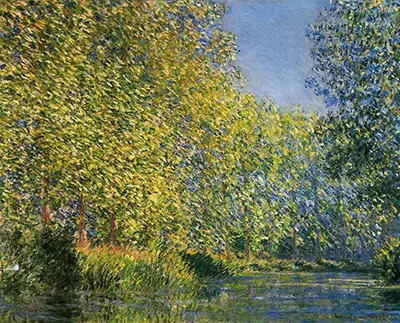The picturesque little village sits on the banks of the Epte, a river which appears again and again in the artist’s works - eventually, he even diverted a branch of the river to create his famous water garden.
Bend in the River Epte is one of Monet’s earlier paintings of the river, likely dated 1888.
Bend in the River Epte depicts a row of poplar trees at the height of spring, their masses of dainty leaves illuminated by rays of golden sun. Monet deftly captures the play of light and shadow as the trees bend over the river, seeming to melt over the grassy banks, down into the water and out into the middle distance as the river lazily meanders along.
The frame is filled with refracted flecks of yellow and green, peach pink, violet and blue. Perspective puts the viewer in the middle of the river, as if floating down it on a boat, which Monet himself often was when he painted scenes like Bend in the River Epte, using his boat as a mobile studio.
Painted in Monet's characteristic Impressionist style, Bend in the River Epte could even be described as a classically Impressionist work. The gentle frenzy of foliage and the playful dapple of sunlight is captured effortlessly thanks to the Impressionist principle of painting out of doors, quickly and spontaneously, to seize a glimpse of nature in motion before it disappears forever.
Oil paint is dabbed onto the canvas in short, thick strokes with little mixing, delineating the essence of the scene without trying too hard to pin down every detail. It's a technique which transports the viewer into the painting, bringing to life the very moment in which Monet painted. The artist's career influenced the likes of Degas, Renoir and Caillebotte.
Great Impressionist paintings like Bend in the River Epte don’t simply give you something to look at - they arouse each one of your senses, so you can almost feel the warm sun on your skin and smell the freshness of the breeze.
Bend in the River Epte is one of many views of poplar trees which Monet painted during his time at Giverny. He captures the trees in every type of light, varying from season to season, at different times of day.
Still, Bend in the River Epte differentiates itself from Monet’s later poplar series of 1891 by putting the emphasis on the blur of foliage - by contrast, in later works from the series, uniformly tall tree trunks stand out in the foreground.
These seem almost starkly bare when compared with this depiction in Bend in the River Epte, and as such the difference in mood and tone is striking. In Monet’s skilled hands the same trees along the same river can sometimes bring about a mood of lazy, peaceful warmth and at other times create a sense of lingering, lonely melancholy.


